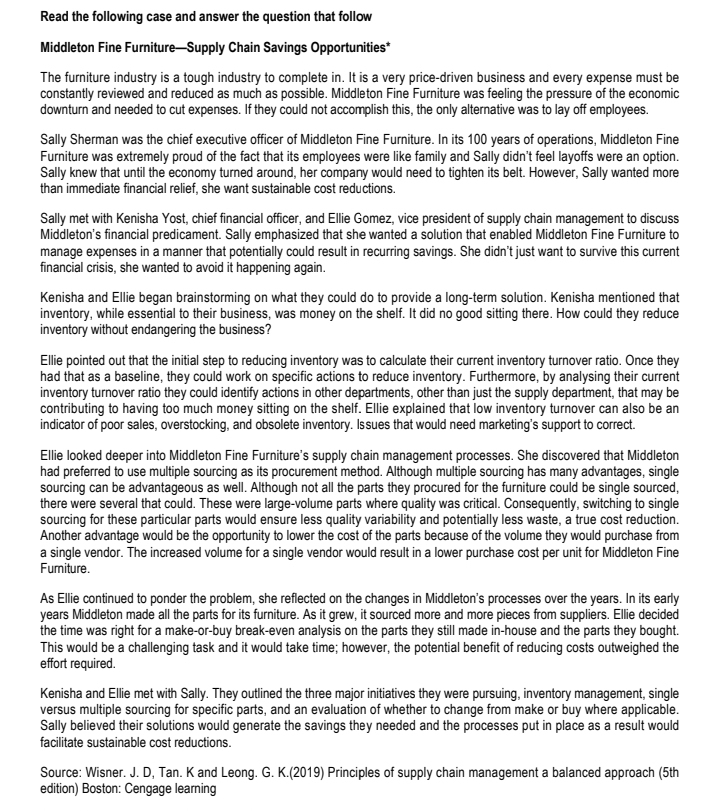With reference to the case study, outline the reasons Ellie had for favouring single sourcing as opposed to multiple sourcing
With reference to the case study, outline the reasons Ellie had for favouring single sourcing as opposed to multiple sourcing
Practical Management Science
6th Edition
ISBN:9781337406659
Author:WINSTON, Wayne L.
Publisher:WINSTON, Wayne L.
Chapter2: Introduction To Spreadsheet Modeling
Section: Chapter Questions
Problem 20P: Julie James is opening a lemonade stand. She believes the fixed cost per week of running the stand...
Related questions
Question
With reference to the case study, outline the reasons Ellie had for favouring single sourcing as opposed to multiple sourcing

Transcribed Image Text:Read the following case and answer the question that follow
Middleton Fine Furniture-Supply Chain Savings Opportunities*
The furniture industry is a tough industry to complete in. It is a very price-driven business and every expense must be
constantly reviewed and reduced as much as possible. Middleton Fine Furniture was feeling the pressure of the economic
downturn and needed to cut expenses. If they could not accomplish this, the only alternative was to lay off employees.
Sally Sherman was the chief executive officer of Middleton Fine Furniture. In its 100 years of operations, Middleton Fine
Furniture was extremely proud of the fact that its employees were like family and Sally didn't feel layoffs were an option.
Sally knew that until the economy turned around, her company would need to tighten its belt. However, Sally wanted more
than immediate financial relief, she want sustainable cost reductions.
Sally met with Kenisha Yost, chief financial officer, and Ellie Gomez, vice president of supply chain management to discuss
Middleton's financial predicament. Sally emphasized that she wanted a solution that enabled Middleton Fine Furniture to
manage expenses in a manner that potentially could result in recurring savings. She didn't just want to survive this current
financial crisis, she wanted to avoid it happening again.
Kenisha and Ellie began brainstorming on what they could do to provide a long-term solution. Kenisha mentioned that
inventory, while essential to their business, was money on the shelf. It did no good sitting there. How could they reduce
inventory without endangering the business?
Ellie pointed out that the initial step to reducing inventory was to calculate their current inventory turnover ratio. Once they
had that as a baseline, they could work on specific actions to reduce inventory. Furthermore, by analysing their current
inventory turnover ratio they could identify actions in other departments, other than just the supply department, that may be
contributing to having too much money sitting on the shelf. Ellie explained that low inventory turnover can also be an
indicator of poor sales, overstocking, and obsolete inventory. Issues that would need marketing's support to correct.
Ellie looked deeper into Middleton Fine Furniture's supply chain management processes. She discovered that Middleton
had preferred to use multiple sourcing as its procurement method. Although multiple sourcing has many advantages, single
sourcing can be advantageous as well. Although not all the parts they procured for the furniture could be single sourced,
there were several that could. These were large-volume parts where quality was critical. Consequently, switching to single
sourcing for these particular parts would ensure less quality variability and potentially less waste, a true cost reduction.
Another advantage would be the opportunity to lower the cost of the parts because of the volume they would purchase from
a single vendor. The increased volume for a single vendor would result in a lower purchase cost per unit for Middleton Fine
Fumiture.
As Ellie continued to ponder the problem, she reflected on the changes in Middleton's processes over the years. In its early
years Middleton made all the parts for its furniture. As it grew, it sourced more and more pieces from suppliers. Ellie decided
the time was right for a make-or-buy break-even analysis on the parts they still made in-house and the parts they bought.
This would be a challenging task and it would take time; however, the potential benefit of reducing costs outweighed the
effort required.
Kenisha and Ellie met with Sally. They outlined the three major initiatives they were pursuing, inventory management, single
versus multiple sourcing for specific parts, and an evaluation of whether to change from make or buy where applicable.
Sally believed their solutions would generate the savings they needed and the processes put in place as a result would
facilitate sustainable cost reductions.
Source: Wisner. J. D, Tan. K and Leong. G. K.(2019) Principles of supply chain management a balanced approach (5th
edition) Boston: Cengage leaming
Expert Solution
This question has been solved!
Explore an expertly crafted, step-by-step solution for a thorough understanding of key concepts.
This is a popular solution!
Trending now
This is a popular solution!
Step by step
Solved in 2 steps

Follow-up Questions
Read through expert solutions to related follow-up questions below.
Follow-up Question
Using the case study as reference, justify to Ellie and and her team how they can use RFID to manage inventory
Solution
Recommended textbooks for you

Practical Management Science
Operations Management
ISBN:
9781337406659
Author:
WINSTON, Wayne L.
Publisher:
Cengage,

Operations Management
Operations Management
ISBN:
9781259667473
Author:
William J Stevenson
Publisher:
McGraw-Hill Education

Operations and Supply Chain Management (Mcgraw-hi…
Operations Management
ISBN:
9781259666100
Author:
F. Robert Jacobs, Richard B Chase
Publisher:
McGraw-Hill Education

Practical Management Science
Operations Management
ISBN:
9781337406659
Author:
WINSTON, Wayne L.
Publisher:
Cengage,

Operations Management
Operations Management
ISBN:
9781259667473
Author:
William J Stevenson
Publisher:
McGraw-Hill Education

Operations and Supply Chain Management (Mcgraw-hi…
Operations Management
ISBN:
9781259666100
Author:
F. Robert Jacobs, Richard B Chase
Publisher:
McGraw-Hill Education


Purchasing and Supply Chain Management
Operations Management
ISBN:
9781285869681
Author:
Robert M. Monczka, Robert B. Handfield, Larry C. Giunipero, James L. Patterson
Publisher:
Cengage Learning

Production and Operations Analysis, Seventh Editi…
Operations Management
ISBN:
9781478623069
Author:
Steven Nahmias, Tava Lennon Olsen
Publisher:
Waveland Press, Inc.